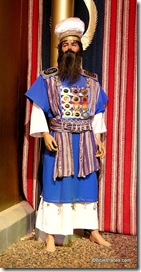It’s a myth. Sorry to ruin such a good story for you.
The notion that the high priest would tie a rope around his ankle before entering the Holy of Holies on Yom Kippur (the Day of Atonement) so that his body could be pulled out should he  be struck down is not found in any ancient source, including the Hebrew Bible, the New Testament, the Dead Sea Scrolls, Josephus, the Apocrypha, the Mishnah, the Babylonian Talmud, or the Jerusalem Talmud.
be struck down is not found in any ancient source, including the Hebrew Bible, the New Testament, the Dead Sea Scrolls, Josephus, the Apocrypha, the Mishnah, the Babylonian Talmud, or the Jerusalem Talmud.
The earliest reference that I know of is in a 13th century A.D. Jewish work, the Zohar:
A knot of rope of gold hangs from his leg, from fear perhaps he would die in the holy of holies, and they would need to pull him out with this rope.
The Zohar says a lot of other things that are not trustworthy. In fact, wearing such a rope would probably be a violation of Leviticus 16:3-4, which gives clear directions on what the high priest is to wear on Yom Kippur:
But in this way Aaron shall come into the Holy Place: with a bull from the herd for a sin offering and a ram for a burnt offering. 4 He shall put on the holy linen coat and shall have the linen undergarment on his body, and he shall tie the linen sash around his waist, and wear the linen turban; these are the holy garments. He shall bathe his body in water and then put them on. (ESV)
John Gill cites this story in his Exposition of New Testament, published in 1746-48. Concerning Hebrews 9:7, he cites “Zohar in Lev. fol. 43. 3. & Imre Binah in ib”:
The Jews say, that a cord or thong was bound to the feet of the high-priest when he went into the holy of holies, that if he died there, the rest might be able to draw him out; for it was not lawful for another priest to go in, no, not an high-priest, none besides him on the day of atonement.
There are many websites and other sources that perpetuate this legend (including the NIV Study Bible on Exodus 28:35).
Another webpage that discusses this myth is located at ChristianAnswers.net.
UPDATE (8/27/09): Rabbi Dr. Ari Z. Zivotofsky has written a lengthy article refuting the claim in the Zohar.